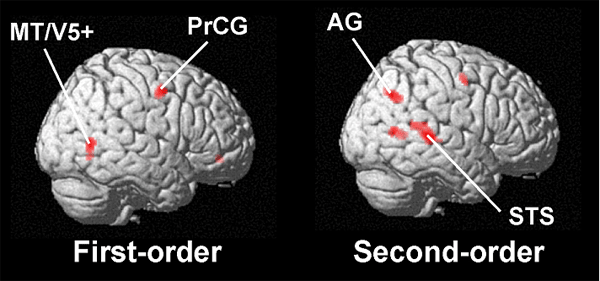While moving objects are usually seen using luminance (first-order) cues, humans can perceive the motion of objects via non-luminance (second-order) cues. Contrary to previous case reports, no physiological studies have elucidated distinct differences in the cortical regions involved in first- and second-order motion processes. We investigated brain responses related to these two types of motion perception in human subjects using 3 T functional magnetic resonance imaging and strictly controlled apparent motion stimulus pairs. Comparison of brain activation to moving versus static states of each motion stimulus isolated cortical activity related to each type of motion perception. We found a selective neural response to second-order motion stimulus in the anterior part of the superior temporal sulcus (STS) contralateral to stimulus presentation and cue-invariant activation of MT⁄V5+. No significant activation in the STS was observed by the first-order motion, even when its visibility was reduced to levels comparable to that of second-order motion. Furthermore, the STS demonstrated significant activation for highly visible motion stimulus with both first- and second-order attributes. The STS represents the cardinal structure for perception of second-order motions, although further studies are needed to elucidate the exact neural process occurring in this area.
Noguchi Y, Kaneoke Y, Kakigi R, Tanabe HC, Sadato N: Role of the Superior Temporal Region in Human Visual Motion Perception. Cerebral Cortex, 2005 15: 1592-1601
